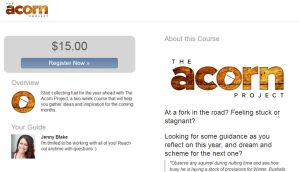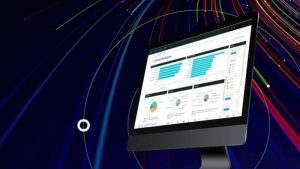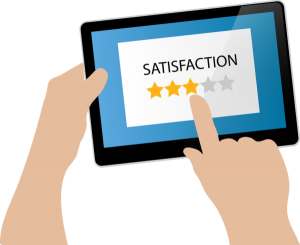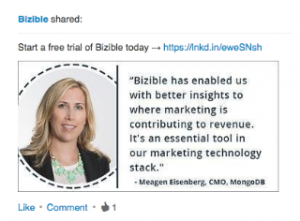— February 19, 2018

geralt / Pixabay
Social media still matters as a discovery tool for B2B decision-makers, so it should certainly matter to demand marketers.
Research by CMI and SmartBrief found that social is a huge part of both how B2B buyers engage with brands, and how marketing organizations start conversations. In fact, the study showed that social media content is the most widely used B2B content marketing tactic, used by 83% of organizations. Perhaps this is because 8 out of 10 B2B buyers trust recommendations from peers and influencers more than original brand research (74%), eBooks (33%) and blogs (21%) – and social media supports such peer review.
B2B buyers want credible, tailored and research-driven content. Demand generation marketers who understand how best to leverage social media to distribute such content will benefit from significant pipeline growth.
4 Ways to Use Social Media in Demand Generation
Demand generation is a full-funnel approach to cultivating a desire for your products or services, using relevant content, leveraging a multi-channel customer engagement strategy and building authentic relationships. When used effectively, social media can greatly help with all three efforts.
Will McInnes, CMO at Brandwatch, writes that social isn’t just for distribution, it’s also valuable for, “researching and better understanding your industry’s current market landscape and consumers.”
The four most critical ways demand marketers should leverage social today involve much more than just lead generation, they also include research, listening and nurturing.
Role #1: Social Media for B2B Research
Jillian Ryan, Analyst at eMarketer writes B2B marketers need to “research to understand audience behaviors on social platforms to deliver targeted content to the right person, on the right network, at the right time in the buyer journey.”
These insights, according to Ryan, can be gleaned via social data mining and social listening.
Social media research is most valuable if it’s targeted deeper than just your existing social media analytics, like who’s engaging with your posts. These insights definitely have value, but they’re not nearly as deep as social intelligence can go.
Social research enables you to:
- Understand the influencer landscape
- Align your content with newly trending topics
- Assess your target audience and competitors
- Tap into the pain points that are driving discussions
When reshaped into questions, the types of insights B2B buyers gain include:
- What are your personas talking about?
- What types of content (asset categories, sources, topics) are they sharing?
- Who are the influencers in your niche?
- Where are these conversations taking place: on publications, influencer pages or in LinkedIn groups?
- Who are the trusted sources of information in your industry?
- Which platforms are actually most popular?
- Which industry events are driving the most social conversations?
- How often does your audience recommend B2B vendors? (CMI research reveals that, on average, just 5% make recommendations on social. )
You don’t need a data science team to discover trends.
Social data-mining tools can scale across huge audiences, and give you the intelligence you need – like the top five topics driving conversations among your target decision-makers. Use these insights to shape your personas, messaging and content strategy.
Keep in mind, however, that social research technologies are invaluable for macro-level insights, but they also don’t always reveal nuance. Social B2B marketers are wise to become active participants in places where conversations are happening on the ground, such as LinkedIn groups or Quora. When combined with social research data, these participants’ observations can reveal the whole picture.
Role #2: Social Media for Listening & Monitoring
Wait, social listening? Doesn’t our CRM already take care of that?
It’s true that modern CRM and MAP offer built-in social listening capabilities, to offer marketing and sales team members deeper insight into prospect and customer behaviors on social media. However, that’s not quite the same as social listening. A lot of social media activity happens outside the view of popular MarTech. RadiumOne research reports 84% of content sharing on social takes place on “dark social,” or private channels such as email or messages.
Social listening is more than just automated prospect and customer monitoring. It’s real-time reports, enabled by listening technologies, that allows you to understand factors like messaging-driven content share tracking, fast-rising influencers and breaking news stories. The difference between social listening and research is subtle, but listening is inherently real-time and behavioral-focused to enable B2B marketers to understand behaviors as they unfold.
Deeper social listening allows you to understand the full picture of your prospects, customers, competitors and influencers in your space, and can reveal:
- Windows of opportunity to engage prospects
- Deeper intelligence through lead scoring
- Lead engagement with relevant topics, conversations or competitors
Tools for deeper social listening can reveal the full picture, including richer intent insight. By integrating social listening tools into your MarTech stack, you can also gain big-picture insights, like influencers who are rapidly gaining followers, topics that are gaining social media search, and the news stories and publications that are getting clicks.
Role #3: Social Media for Lead Generation
Regardless of how you’re using social media for lead generation – whether it’s owned or paid efforts, or both – your lead generation efforts are likely to be a lot more effective if they’re informed by social research and listening.
Lead generation on social is best when it’s informed by fresh data. When it comes to HOW to do it, there are quite a few ways to use social as a top-of-funnel lead source.
B2B marketers are driving success with a variety of campaigns, including:
- Offers
- Contests
- Polls and surveys
- Discount codes and loyalty programs
- Gated content on social (enabled by social sign-on technology to capture lead data)
- Real-time conversations, including socially hosted webinars and Twitter Chats
- Paid social advertising
Role #4: Social Media for Lead Nurturing
What’s the product of social research, listening and lead generation?
It’s the next step, social lead nurturing. This isn’t quite the same as social selling – when sales personnel use social media to engage directly with prospects – but these two concepts are definitely adjacent, even overlapping.
Social intelligence technologies can reveal which prospects actively share your content, follow your competitors or post to LinkedIn about their pain points. These actions contribute to “intent” or behavioral data, which automation technologies can use to reassign these leads to a different lead nurturing track or convert marketing-qualified leads (MQLs) to sales-qualified leads (SQLs).
Social lead nurturing involves more than just gleaning social media insight into intent-to-buy, behavior and other insights. It means having the social media presence to join conversations that are taking place and engage directly with opportunities on social, including posting the right piece of content or an answer from a knowledgeable insider.
Social media is inherently social and taking a personal approach to lead nurturing when it’s warranted can set your brand apart and boost closed-won deals.
Using Paid Targeting for Social Lead Nurturing
While one-to-one targeting on social media isn’t quite yet a possibility, at least not technically, all major social media networks except for Snapchat offer built-in “advanced targeting” capabilities to offer finely tuned audience targeting.
With LinkedIn, marketers can target individuals by company name, job title, field of study, groups and age. With enough prospect insights, that’s enough targeting possibilities to make one-to-one content targeting a possibility. Within the context of some demand generation strategies or industries, such as an account-based marketing strategy or very narrow audience niche, near one-to-one content distribution may be a high-return tool for social lead nurturing.
Much More Than Lead Generation
Demand generation marketers are familiar with social media’s potential for both paid and organic lead generation, but social has a lot more potential. When used as a tool for research, listening and lead nurturing, it can help you understand your prospects and close deals.
That information and understanding reveals positive insights that will benefit your entire marketing plan.
“What does your customer journey look like?” “Is your current MarTech stack integrated enough, and are you missing any tools?” These are some of the hardest questions in B2B marketing today. To access a blueprint for evaluating how your demand generation processes and technology are working together, click here to download the Marketing Tech Blueprint Workbook.
Digital & Social Articles on Business 2 Community
(59)
Report Post








